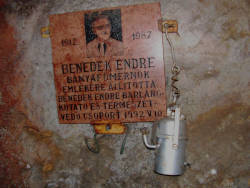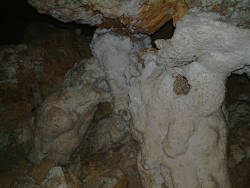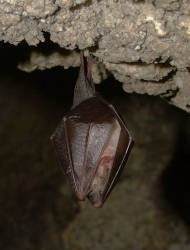Sátorkőpusztai-barlang
Strázsahegyi-alsóbarlang - Esztergom-Őrhegyi Kristálybarlang
Useful Information



| Location: |
Dorog, Danube-Ipoly National Park.
(47.741914, 18.762067) |
| Open: |
By reservation. MAR to NOV one day per month, on the weekend. [2022] |
| Fee: |
free. Donations welcome. [2022] |
| Classification: |
 Karst Cave Karst Cave
|
| Light: |
 LED LED
|
| Dimension: | L=354 m, VR=61 m, A=253 m asl, T=13 °C, H=95-98 %. Cadastral Number 4851-1. |
| Guided tours: | |
| Photography: | allowed |
| Accessibility: | no |
| Bibliography: | |
| Address: |
Benedek Endre Barlangkutató és Természetvédelmi Egyesüle (BEBTE), Dorog, Cell: +36-20-396-7386.
E-mail: |
| As far as we know this information was accurate when it was published (see years in brackets), but may have changed since then. Please check rates and details directly with the companies in question if you need more recent info. |
|
History
| 1944 | crack discovered by quarry workers working under the control of the German army, but not recognized as a cave. |
| 1946 | cave discovered by Károly Várhidi, Rezső Várhidi and others, cave surveyed and listed. |
| 1947 | cave became known to the public, 80% of cave formations destroyed within 5 years. |
| 1948 | guidebook published by István Szegő mentions the cave. |
| 1958 | explored by members of the Ottokár Kadić Cave Research Group from Dorog, lead by mining engineer Endre Benedek. |
| 1958 | opened to the public without actual development on semi wild tours. |
| 1976 | Kadić section discovered. |
| 1989 | BEBTE founded, became caretaker of the cave. |
| 1992 | inauguration of Endre Benedek’s memorial plaque. |
| 1993 | opened for cave trekking tours. |
| 1996 | cave washing with firefighters from Nyergesújfalu. |
| 17-MAY-2001 | declared a highly protected cave. |
| 2010 | use of high-pressure washing technology for cleaning. |
| 2012 | discovery of Pentecostal branch. |
| 2014 | removal of clay layer reveals spectacular pea stone formations. |
| 2014 | old iron ladders replaced with stainless steel, supported by the KEHOP tender project of the Danube-Ipoly National Park. |
Description


Sátorkőpusztai-barlang (Tentstone Cave) is a wild cave which is protected by the BEBTE, a local caving and nature protection club. They also offer cave trekking tours into the cave, which is famous for its various speleothems and called a crystal cave. There are calcite, aragonite, and gypsum crystals, but also goethite and baryte, which is quite exceptional and the result of hydrothermal activity. The cave has a shaft in which an iron ladder with a cage is installed. The rest of the cave is either more or less level or easy climbing over blocks. The visitors are equipped with full caving gear, but except for the climb down the ladder the tour is rather easy. And because of the minerals in the cave, it is quite interesting.
The cave was discovered in 1946, and in the following year news spread. This was quite unfortunate for the cave, as people went there to visit and take a souvenir home. In only five years 80 % of the formations was destroyed. The town Dorog is a miner town, the locals thought this was just another natural resource, existing to be exploited.
In 1958 members of the Kadić Ottokár Barlangkutató Csoport (Ottokár Kadić Cave Research Group) from in Dorog explored the cave. The speleological exploration was under the leadership of mining engineer Endre Benedek. They extended the known passages by discovering more branches. The group also explored other caves in the area, like the adjacent Strázsa-barlang (Strázsa Cave) or the Pilisnyergi-víznyelőbarlang (Pilisnyergi Sink Cave) a few kilometers away. They offered cave tours for the public, but it was not developed as a show cave. The cave tours faded away some time later, so did the caving club, but there is no official end date for both. It seems they finally dissolved in 1988.
When BEBTE became caretaker of the cave, half a century later, they had only vague descriptions of the original state. They nevertheless started with a cave wash, they actually washed down the dust of generations with the help of the firefighters from Nyergesújfalu. The dirt which was brought in by vandals was massively removed. Until today probably 100 tons of clay were removed from the cave revealing speleothems which were formerly covered by the clay and thus protected from the vandalism.
Today the cave one of a few caves in Hungaria under special protection, which they call "fokozottan védett". It is owned by the state, its administrator is the Directorate of the Danube-Ipoly National Park (DINPI). BEBTE is preserving and researching the cave and operating tours for the public it since 1993. Since this year it is also the only cave in the county which is open to the public.
On Pentecost in 2012 a new cave branch was discovered, which was named Pentecostal Branch, obviously. It showed them, how the cave originally looked, full of crystals. Its only 6 m long, but a treasure. In this case it was easy to protect, as the cave was closed by the club right at the beginning of their work, and visitors were allowed only if guided by club members. And there were further discoveries, like the spectacular pea stone formations which were found by removing a clay cover. To avoid the damage to formations on the floor they even built artificial trails, so people woukd stay on the elevated trails and not trample the formations. The KEHOP tender project of the Danube-Ipoly National Park helped with the funding of new stainless steel ladders, replacing the old iron ladders.
The BEBTE offers cave tours on one weekend day, once per month, from March to November. There are tours throughout the day. Reservation is required, so you will get the date and time with the reservation. They publish updates on their blog, but if you are interested in a tour you should contact them directly.
- See also
 Search DuckDuckGo for "Sátorkőpusztai-barlang"
Search DuckDuckGo for "Sátorkőpusztai-barlang" Google Earth Placemark
Google Earth Placemark Sátorkőpusztai-barlang
Sátorkőpusztai-barlang  - Wikipedia (visited: 14-APR-2022)
- Wikipedia (visited: 14-APR-2022) Sátorkőpusztai-barlang, official website
Sátorkőpusztai-barlang, official website  (visited: 14-APR-2022)
(visited: 14-APR-2022) Virtual Tour (visited: 14-APR-2022)
Virtual Tour (visited: 14-APR-2022) Sátorkőpusztai-barlang (visited: 14-APR-2022)
Sátorkőpusztai-barlang (visited: 14-APR-2022) Sátorkőpusztai Cave, Dorog - mindat.org (visited: 14-APR-2022)
Sátorkőpusztai Cave, Dorog - mindat.org (visited: 14-APR-2022)
 Index
Index Topics
Topics Hierarchical
Hierarchical Countries
Countries Maps
Maps